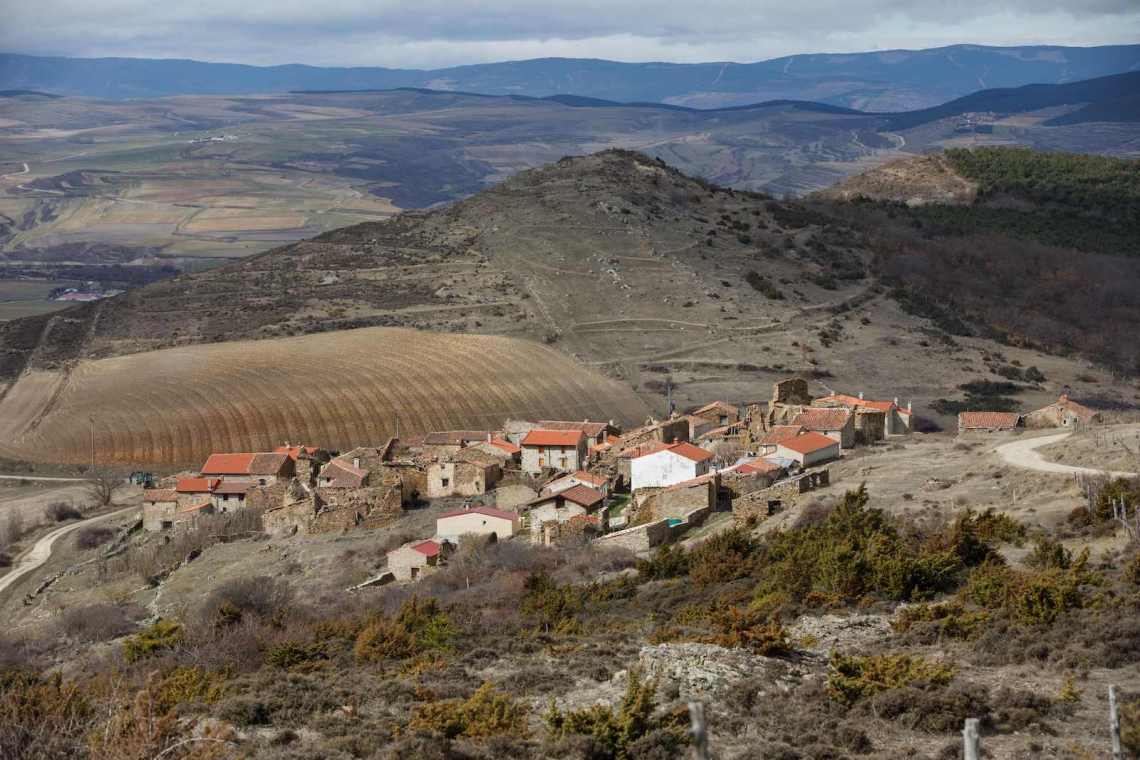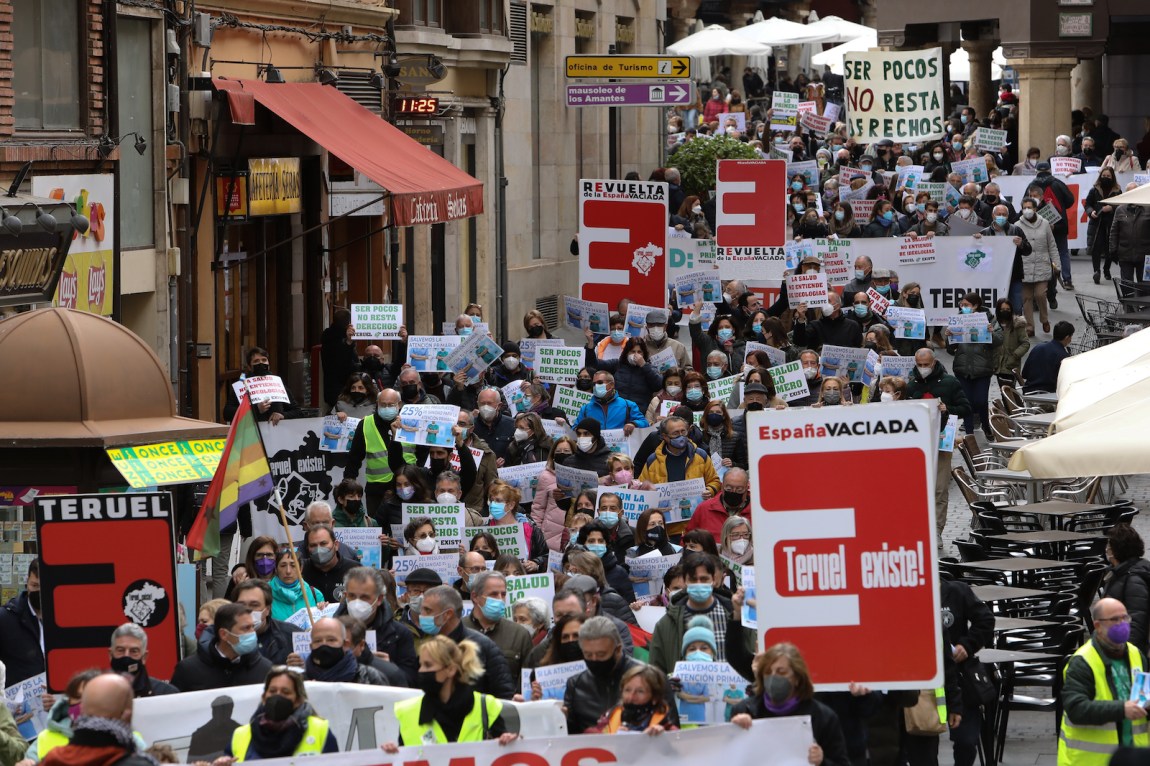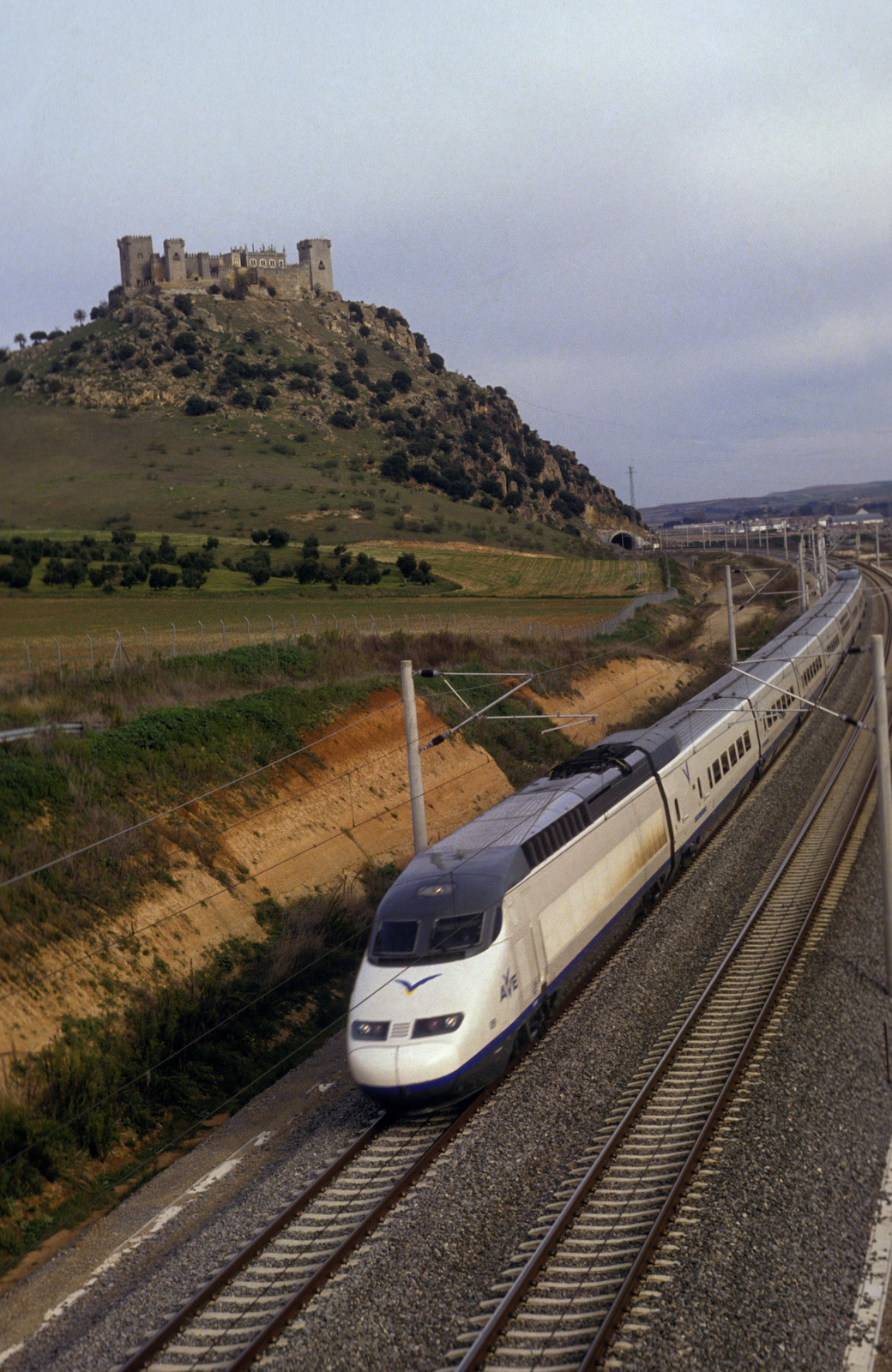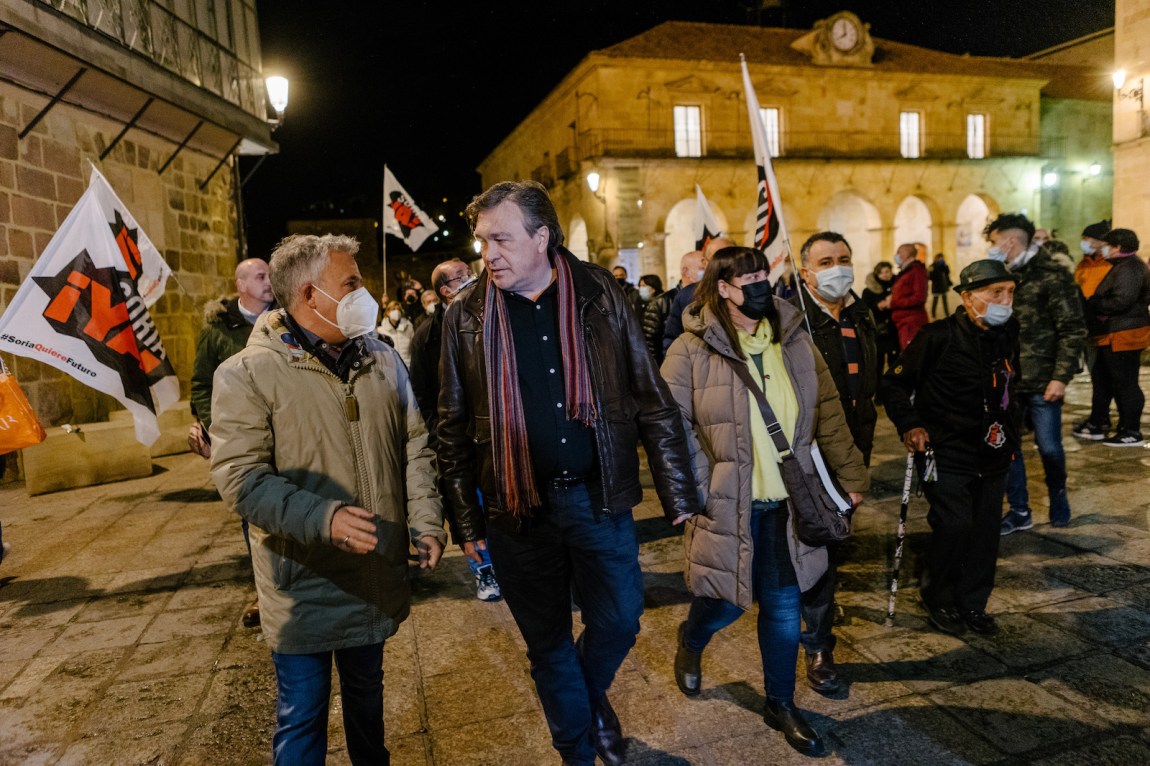On March 31, 2019, residents of Madrid woke up to a mass demonstration of some 100,000 people in the streets decrying the problem of sangría demográfica, or demographic hemorrhaging. This arresting metaphor alludes to a depopulation crisis that has left large swaths of Spain barely inhabited. Under the banner “The Revolt of Emptied Spain,” protesters from twenty-four rural provinces complained of neglect from government agencies, poor Internet service, lack of access to transportation and healthcare, and indifference from Spanish multinationals and those who live in Spain’s thriving urban centers. Inspired by other successful demonstrations in the capital, such as those that led to the legalization of same-sex marriage in 2005, their signs invoked the rhetoric of social justice and human rights: “Equality for all,” “My choice of lifestyle does not deprive me of my rights,” and “I am a rural citizen, and I am in danger of extinction.”
Data from Spain’s National Statistics Institute (INE) paint a startling picture of the country’s shifting demographics. Some 90 percent of the population, about 42 million people, is currently clustered in 1,500 towns and cities that occupy less than a third of the land. The remaining country is inhabited by 4.6 million people, roughly the number that live in Barcelona. The INE also reports that some 80 percent of villages of less than a thousand residents are at risk of disappearing altogether as their populations age and young people leave, which explains the abundance of ghost towns familiar to travelers to the interior of Spain. According to the real-estate company Aldeas Abandonadas, or Abandoned Villages, there are about 1,500 hamlets that can be had for less than $100,000, most of them in Aragón, Castilla y León, Castilla-La Mancha, Extremadura, and La Rioja. These five interior regions—known as the Spanish heartland because they were the birthplace of the Kingdom of Spain and its colonial empire—make up 53 percent of the national territory, yet are home to only 15 percent of the population. The province of Zamora, in Castilla y León, has seen its population drop by over 30 percent since 1975, even as the population of the country as a whole has grown by 30 percent in the same period.
Paradoxically, Spain’s depopulation crisis is taking place in the middle of an immigration boom. In recent decades millions of newcomers, most from Latin America, the UK, Eastern Europe, and other EU countries, have kept Spain’s population growing. They come to Spain looking for better economic opportunities or a place to retire with a warm climate, a highly developed health-care system, ample cultural opportunities, and an affordable cost of living by European standards. In 1998 immigrants accounted for less than 2 percent of the Spanish population, but as of 2020 that figure had reached 15 percent, one of the highest in Europe, encouraged by some of the most progressive immigration policies in the EU. The vast majority of immigrants, however, choose to settle in major urban centers where they can easily secure the paperwork needed to get work permits, language lessons, and citizenship.
The social and economic consequences of depopulation are shown in stark relief in a recent report by the Bank of Spain. The average rural citizen must now travel 8 miles to access basic services such as ATMs, hospitals, nursery schools, supermarkets, and libraries—compared to 3 miles in Germany, 5 in France, and 3 in Italy. The report further noted the striking disparities found within Spain itself: people living in the countryside travel an average of 12 miles more than those living in cities. Such dire conditions have propelled a political movement that calls itself “España Vaciada,” or Emptied Spain; the Spanish media generally refers to it as “España Vacía,” or Empty Spain.
Teruel, a city in the northern region of Aragón, is the epicenter of the movement. Known for its cured ham, medieval architecture, and harsh winters, it is the only Spanish provincial capital not linked to Madrid by either a direct highway or a railway. (A running joke in Spain is that “Teruel does not really exist.”) As of 2017, the province of Teruel had an average density of 4.2 inhabitants per square mile—lower than that of Lapland. Tomás Guitarte, Teruel’s representative in the Congress of Deputies in Madrid, founded a political party in 1999, defiantly named Teruel Existe, with a platform of improving the quality of life and reversing population decline in rural Spain. When we communicated this spring, Guitarte described the situation in Teruel and other rural areas in apocalyptic terms: “Hundreds of Spanish villages will disappear in ten years unless something is done right now.”
*
Rural depopulation in Spain is generally attributed to two underlying causes. The first is Spain’s fertility rate, which was 1.2 percent in 2020, tied with Italy for the second lowest in the EU, after Malta. Fertility rates have been below the replacement level in most EU countries for decades, but Spain is an outlier for having higher fertility rates in its urban areas than its rural towns, where the problem is compounded by a growing gender imbalance as women flee the countryside. According to the social anthropologist Jeremy MacClancy, the persistence of traditional gender roles in Spain’s rural regions has driven rural women to seek greater freedom in the cities. In the interviews that he conducted in the 2000s in the village of Cirauqui, some nineteen miles south of Pamplona in the northern region of Navarra, middle-aged women complained that “they were obliged to assist their husbands in whatever agricultural task they could, as well as run the home and raise the children.” In his 2020 essay “Where Are the Women of Empty Spain?” MacClancy writes that “these frustrated women wished to leave what they felt was a suffocating local ambience,” whereas in the cities, as one woman put it, “the air was made of pure liberty.”
Advertisement
A dearth of economic opportunities is the second cause. Spain was an agrarian society until the late 1950s, when industrialization and mass tourism took off. Today, however, agriculture represents less than 3 percent of Spain’s GDP. Although agriculture remains a bedrock for many Spanish rural communities, employment opportunities have been vastly reduced due to mechanization, the rise of large agrarian conglomerates, and increasingly harsh working conditions. Spain is famous for its epic droughts; the worst lasted three years in the 1940s and was aggravated by the devastation the followed the civil war and the isolation imposed by the West on Franco’s fascist dictatorship. At that time, food assistance from Juan Perón’s friendly government in Argentina kept many Spaniards from starvation.
More recently, climate change has been exacerbating droughts. In the last three months of 2021 Spain recorded just 35 percent of the average rainfall it saw during the same period from 1981 to 2010, and there was virtually no rain this past January—an anomaly that has only happened once before, in 2005. The dry spells also contribute to wildfires; this summer Extremadura and Castilla y León have been especially hard hit. Between 2008 and 2019 Spain led the EU in the number of people displaced by weather events—64,360—followed by France and Germany. Almost two thirds of these displacements were the result of wildfires. The rest were caused by floods, including those brought by Storm Gloria last year, which killed fifteen people and displaced five hundred.
But while low fertility rates and climate change are forcing demographic shifts in other parts of western Europe, countries like Italy and France appear to have managed to keep their rural regions in better shape. A more persuasive explanation for Spain’s depopulation crisis is the approach that the Franco dictatorship took to industrial development. In Guitarte’s telling, these policies created a “developed Spain” and an “empty Spain.” In the 1960s the Franco regime put the resources of the rural regions in the service of large cities and coastal tourist communities. “The rural communities contributed their primary goods (agriculture and mining) and exported their people, and got very little in return.”
For the Franco regime, investing in cities and coastal communities was as much a political decision as it was an economic one. Some twenty years after the civil war, Franco was in need of a new rationale for staying in power, and he found one in the lofty rhetoric of “modernization” and all that it required. Casting himself as the West’s most ardent anticommunist crusader, Franco opened the country to economic aid from the World Bank and technical expertise from the International Monetary Fund, as well as access to foreign investment from multinational corporations. Since the end of the dictatorship that came with the democratic elections of 1977, and Spain’s entry into the European Union (then known as the European Economic Community) in 1986, development strategies have continued to favor cities and coastal communities over the countryside.
A case in point is Spain’s high-speed rail. Credited with boosting tourism and commerce while reducing traffic congestion and accidents—as well as serving as a model for American states like California—the AVE system (Alta Velocidad Española, or High Spanish Velocity, an acronym that aptly means “bird”) is one of the jewels of economic development in the post-Franco era, second in size only to China’s. If you catch an AVE train from Madrid’s Atocha station, you’ll be in downtown Barcelona in two hours and thirty minutes, a journey that was historically made overnight. From Spain’s largest cities—Madrid, Barcelona, Valencia, and Seville—high-speed trains fan out to the provincial capitals of Salamanca, Valladolid, Toledo, and Girona, skipping most smaller towns in between.
Advertisement
When plans for the AVE system were laid out in the late 1980s, the Spanish government went to great lengths to anticipate potential environmental effects (especially noise), prevent the destruction of farmland, and protect historical landmarks (in Barcelona, a special tunnel was built to avoid upsetting the foundation of the famed Sagrada Familia cathedral). But not much thought appears to have been given to protecting rural communities from being cut off from the rest of the country. This scenario has come true for thousands of small towns, including Algodor, a hamlet in the province of Madrid whose depopulation woes were recently profiled in El País. According to the paper, Algodor’s once-busy railroad station, built in the 1920s, today sits idle as a consequence of the high-speed AVE link between Toledo and Madrid that opened in 2005. Algodor has basically ceased to exist, with a reported population in 2018 of fourteen people.
*
Teruel Existe has inspired analogous political parties, such as Soria ¡Ya! (Soria Now!) and Jaén Merece Más (Jaén Deserves More). These and other regional organizations, which in September 2021 banded together and registered as a political coalition under the name Emptied Spain, take inspiration from the grassroots anti-austerity movement Indignados (The Angry Ones) that led demonstrations in response to the economic crisis of 2008. Also known as the Great Spanish Depression, the crisis sent unemployment soaring to over a quarter of the labor force, drove hundreds of businesses into bankruptcy, and triggered a separatist revolt in Catalonia. Like the Indignados, Empty Spain has mobilized the public and shamed politicians to get its message across, and foregrounds nonpartisan issues such as political corruption and the high cost of living that have been neglected by the national political parties, the social democratic Spanish Socialist Workers’ Party (PSOE) and the conservative People’s Party (PP).
Empty Spain’s nonpartisan agenda stands in striking contrast to the historic right-wing orientation of Spain’s rural provinces, especially those in the north-central part of the country, the epicenter of the depopulation crisis. During the civil war, north-central Spain was a bastion of support for the Catholic Church and Franco’s nationalist crusade, and in the post-Franco era the region has emerged as the PP’s most reliable electoral base. More recently it has become a stronghold for Vox, Spain’s ascendant far-right party. Vox’s appearance on the national scene in 2019 ended the so-called “Spanish exception,” or the absence of representation of far-right populist parties in the national parliament. Notorious for its invective against women, immigrants, and LGBTQ people, as well as its advocacy for hunting and bullfighting, Vox entered Castilla y León’s regional parliament with thirteen seats this year after winning 17.6 percent of the vote, a dramatic increase from 5.5 percent and one seat in 2019.
The rise of Empty Spain in the very heart of the most conservative parts of Spain poses a direct threat to the PP and Vox. Conservative victories in Spain generally require winning big in the interior. Such victories are aided by electoral laws that, as in other democracies, grant disproportionate representation to rural voters. Provinces like Teruel have 2.2 parliamentary seats per 100,000 residents, compared to 0.6 seats on average for high-density provinces such as Seville, Valencia, Barcelona, and Madrid. The 2019 general elections gave Teruel Existe its first opportunity to show its power, and the party won a seat in the Congress of Deputies and two in the Senate. In this year’s regional elections in Castilla y León, political parties affiliated with Empty Spain ran candidates in five of the region’s nine provinces. In Soria, Soria Now! emerged as the dominant political party with 43 percent of the vote.
Spain’s increasingly fragmented political party system—there are currently more than a dozen parties in parliament—enhances the threat that Empty Spain poses to conservative parties by allowing parties like Teruel Existe to become power brokers. In recent national elections no single party has won enough parliamentary seats to form a government outright, leaving the country vulnerable to power battles between the PSOE and the PP as they scramble to form intraparty coalitions that can become a government. It was this chaotic political environment that allowed Teruel Existe’s sole seat in the 350-seat Congress of Deputies to be decisive in confirming Pedro Sánchez of the PSOE as Spain’s new prime minister in November 2019, a move that angered many on the right and the far right. “If I were from Teruel, I would plant myself in front of City Hall until Guitarte offered his resignation for his betrayal of the Spanish people,” said Santiago Abascal, Vox’s pugnacious head.
Guitarte makes no apologies for supporting a socialist government. “What we did by supporting Sánchez was support the depopulation policies that we promised to pursue during the political campaign,” he told me. In the lead-up to the 2019 election, a contest in which Spain’s rural provinces became fierce battlegrounds, Sánchez pledged to address rural depopulation, and followed up in 2021 with a rescue package totaling 10 million euros to be spent on infrastructure, the relocation of public agencies and institutions to the rural provinces, and the creation of a special ministry for “ecological transition and the demographic challenge.” This aid was announced as urban workers fled to the countryside during the Covid-19 pandemic, where they were met with poor broadband and a lack of technological infrastructure and medical services.
For the PSOE, support from Teruel Existe means more than gaining one more coalition partner. Since the early 2000s the PSOE has struggled to connect with rural voters, in no small measure because of its transformation into a party chiefly concerned with “postmaterial” values that appeal to urban voters, such as feminism, LGBTQ rights, separation of church and state, and historical memory. Sánchez epitomizes these values. A self-described feminist, his cabinet leads all EU countries in its proportion of female ministers: 64 percent, including women in all the key ministries. Sánchez is also famously agnostic. He was sworn in as prime minister with his right hand placed on the Spanish Constitution, rather than on the customary Bible or crucifix. One of his first actions as prime minister was to exhume and remove Franco’s remains from El Valle de los Caídos (Valley of the Fallen), his resting place since 1975, arguing that his burial at a state site was an affront to the victims of the dictatorship. Little wonder that many rural voters have come to regard the PSOE as arrogant and anti-Catholic.
But politics makes for strange bedfellows. PSOE leaders clearly see the crisis in the rural provinces as an opportunity to expand the party’s electoral base, and Sánchez’s own rise has shown that even marginal inroads with rural voters can make the difference between leading the opposition in parliament and governing the nation. For groups like Teruel Existe, the crisis afflicting Spain’s interior regions calls for abandoning zero-sum politics and focusing instead on solving people’s problems. While after the 2019 elections many on the right would have been content for Spain to carry on with a caretaker government—as the country did for much of 2016—this was simply not an option for Guitarte and the people he represents. “We are a transversal movement facing an existential crisis,” he told me. “We will support any option that guarantees governability.”
For those in the Empty Spain movement who have come to view immigration as a potential cure to the depopulation crisis, the recent arrival in Spain of 135,000 Ukrainian refugees is an opportunity not to be missed. Encouraged by a host of Spanish nongovernmental organizations, some Ukrainians have begun to settle in the countryside. Despite the economic and cultural challenges—to say nothing of the trauma of escaping their war-torn country—they could not be happier to have found a home in some of Spain’s most desolate and impoverished areas. “Jesus has brought me to paradise,” said one woman to Euronews about her family’s new life in Aguilafuente, a village of six hundred people in the depths of Castilla y León. Her exuberance reflects how the villagers have rallied to help the refugees, most of them women with young children, whom they see as perhaps the best and last hope for restoring some semblance of vitality to a once thriving Spanish heartland.






